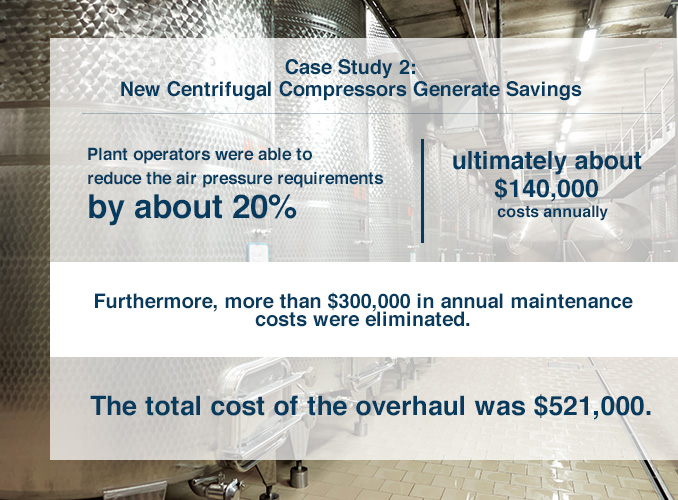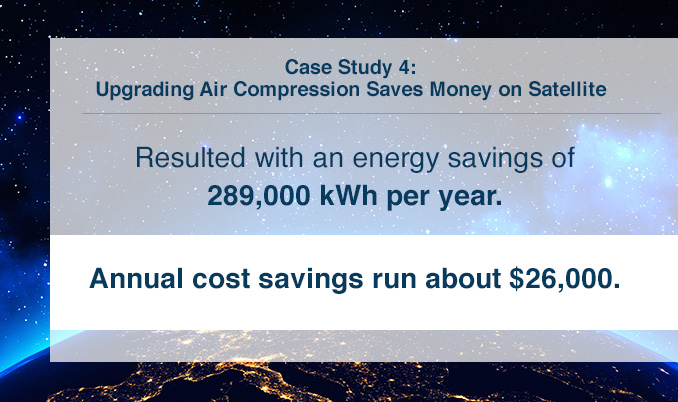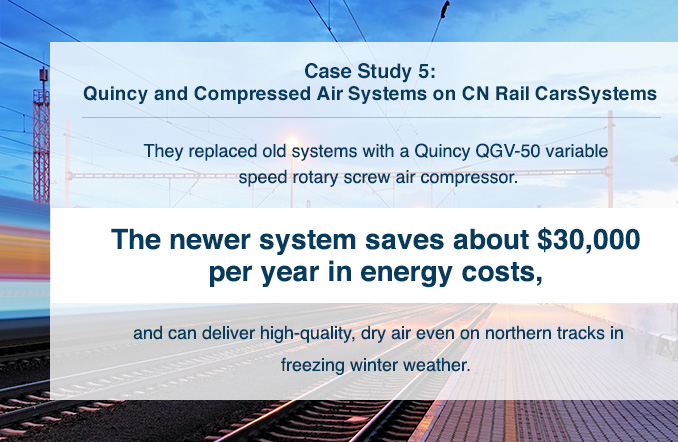When people think about factories that serve all sorts of industry, they often think of robotic machines, assembly lines, conveyor belts, and a perfectly timed series of movements that result ultimately in a finished product. But what makes those machines tick like the inner working of a fine Swiss watch? The answer in many cases is compressed air, and upgrading air compressor systems can provide a company with significant opportunities for cost and energy savings.
What’s Air Compression All About?
If you’ve ever had to “stoke” a fire, then you know about air compression. You breathe air into your lungs and blow it out to increase the oxygenation at the fire source. That’s a practical use of air compression, but nowhere near as practical as the standard bellows that was first put in practice in blast furnaces.
A bellows was a vital invention that allowed us to force compressed air into a furnace much more effectively than just using our lung power. A bellows works by sucking in air into a chamber, which is sealed off by a check valve when the bellows is expanded. Then that air is squeezed out of a nozzle under pressure and directed as desired.
The use of a bellows allowed blacksmiths to create fires that were much hotter than could have been generated otherwise. That led to a range of applications in metallurgy as fires were able to melt important metals, such as copper lead, and iron. Once melted, the metals could be formed into different functionally useful designs, such as a coin or a suit of armor.
It wasn’t long before machines were assisting us in compressing air. Rather than rely on human brute force to open and squeeze close a bellows, steam power could provide the energy needed to compress air much more efficiently.
That in turn led directly to the use of piston-type air compressors, as found in gasoline engines. The pistons are driven by a gasoline-powered engine. The piston is forced down, drawing in outside air. The piston is then forced up, compressing the air in the piston chamber. When put in a high pressure fuel-air mixture and set off by a spark, you can create a very powerful device known broadly as the internal combustion engine.
Air compressors are a vital part of many industry applications. They’re used in fabricating metals, mining operations, ventilating tunnels, railroads, satellite component manufacturing, and a host of other ways. Importantly, modern air compressor technology is vastly improved over prior designs. This offers many opportunities for significant cost savings and energy efficiency.
Basic Types of Air Compressors
It’s important to understand the basic types of air compressors before addressing several case studies of cost savings opportunities. Compressors come in two basic types: positive displacement and roto-dynamic.
Positive displacement compressors act either as a reciprocating compressor or a rotary compressor. Here you can think of piston-based compressors or screw or vane-types of compressors. Roto-dynamic compressors use centrifugal force or axial flow to compress air.
Different types of air compressors are used for different applications, depending on the size required, the horsepower required and, of course, the cost.
More Efficiency from Air Compression Technology
Recently, new designs in various compressors have reduced energy consumption greatly. For example, early air compressors often utilized a load/unload compression. This required storage receiver volume, with the machine operating at full capacity until the unload pressure was reached. After that, the compressor would vent until a lower pressure level was reached and then the cycle would repeat.
This “bang-bang” form of control is very inefficient as compared to a variable displacement control (VDC). In VDC compressor capacity is adjusted by opening and closing pump ports. Some of these variable displacement machines offer five or more set points of compression (rather than all or none); rotary designs can offer a continuously adjustable capacity from 50 percent to 100 percent.
Variable speed drive compressors can provide 35 percent energy savings over load/unload designs. But very new designs use a vertically aligned motor and drive train that share a single drive shaft. This has the benefit of a smaller “footprint.” The tool can be operated closer to the desired point of use. All of this contributes to energy efficient air compression technology.
Case Studies
Case studies provide insights into how outdated and unreliable air compression equipment can be upgraded to yield significant energy and cost savings. Often, the cost of the upgrade can be recouped in 12 to 24 months, making the investment clearly beneficial to a company’s long-term bottom line. Here are four case studies of cost savings in the automotive industry, the steel industry, nuclear fuel production, and satellite systems production that all resulted from a systematic study of observed problems, and upgrading air compressors and their control systems for the desired purpose.
Case Study 1: Motoring to Savings by Upgrading Compressed Air Control Systems
Michelin North America is a large tire manufacturer with a manufacturing plant in South Carolina. At the time of this case study, about 1,000 people worked at the plant to produce truck tires and other automotive parts.
Air compressors are used widely in the automotive industry. Here they were used to drive the production process, powered by five 500-horsepower centrifugal compressors.
The South Carolina plant was identified as having larger air energy costs than a similar plant in Canada. A study was conducted to determine why this was the case. The study identified problems with the compressor control strategy, significant drops in pressure between compressors, and a high air leakage rate that required all five compressors to be operating in order to provide sufficient air pressure for the plant.
The solution was to upgrade the air compressor control system, which in turn maintained an appropriate pressure differential between the compressor pressure settings. A plan for twice-annual routine leak repair was implemented as well. In all, the upgrade created about $75,000 per year in energy savings, and the cost of the upgrade was recouped in about 18 months.
Case Study 2: New Centrifugal Compressors Generate Savings
U.S. Steel Group of Pittsburgh, Pennsylvania is the largest producers of steel products in the USA. It’s also a significant player in the oil and natural gas business. Air compressors play a vital role in the steel industry. At U.S. Steel Group, air compressors have been used for powering two blast furnaces, the powerhouse for the plant, and the basic oxygen plant. The air compressors have served these needs via pneumatic actuators and piston-driven cylinders.
Prior to an independent study to see if an upgrade could improve performance, one U.S. Steel plant relied on six 400-horsepower air and oil-cooled rotary screw compressors. These compressors were old, leaking, and malfunctioned sufficiently often that they could not be relied upon to provide the air pressure needed for the plant’s operations.
Repairing the compressors was going to be very expensive. Fixing the oil leakage problem would have had multiple benefits. The leaks were bad enough that the machines had to be relubricated frequently. Oil managed to contaminate dryers and filters, so these weren’t performing well either.
The solution was to install two new 600-horsepower centrifugal compressors. Located centrally in the plant, they could easily service all demands. Some better performing rotary screw compressors were kept as backups for extreme weather conditions. In addition, equipment upgrades were made to the dryers.
In the end, the plant operators were able to reduce the air pressure requirements by about 20 percent, saving energy and ultimately about $140,000 in costs annually. Furthermore, more than $300,000 in annual maintenance costs were eliminated. The total cost of the overhaul was $521,000, so this was recouped in just over one year.
Case Study 3: Nuclear Processes Benefits from Upgraded Air Compressors
The BWX Technologies plant in Lynchburg, Virginia produces components that contain nuclear fuel for the U.S. Navy. The nuclear fuel and associated reactor parts serve the propulsion units of Navy vessels.
The plant relies on compressed air to recapture uranium, treat waste, and operate its machine shop, including lathes, grinders, and drills. On top of the demands from these operations, vapor blasts put intermittent compressed air demand spikes on the overall system.
Before undergoing an independent study to determine how best to improve operations, the plant relied on two 600-horsepower water-cooled centrifugal compressors. These compressors had to run at full load but vented between one-third and two-thirds of their output – wasted energy going into the atmosphere.
The result of the study was to upgrade to more efficient smaller air compressors. Three 350-horsepower air-cooled rotary screw compressors were installed, along with other equipment. When coupled with a redesigned factory layout that included a special heat exchange room to maximize efficiency in summer and winter, the result was an annual saving of 4.2 million kWh, or about $146,000. In addition, $111,000 of annual water cooler costs were saved and there were lower maintenance costs as well.
Case Study 4: Upgrading Air Compression Saves Money on Satellite Systems
Boeing Satellite Systems, which was known formerly as Hughes Space & Communications Company, makes systems that go on satellites orbiting the Earth. This requires a high degree of precise automation and a unique manufacturing environment. Air compressors in space and satellite system development serve key roles.
At the Boeing plant, air compressors provided air for machines that used balloons to generate vibrationless movement of satellite components. To accomplish this, the machines had to receive constant steady pressure. Boeing had the problem of having unstable pressures generated from two 200-horsepower rotary screw compressors.
The instability was caused by intermittent interruptions in air flow, which caused potential machine shutdowns. In addition, about 25% of the system’s output was leaked air.
A systematic study of the production area identified the opportunity for installing a new pressure/flow controller (P/FL) with additional storage. The extra storage was used to maintain a steady flow. Simultaneously, efforts to repair the leaks in the system reduced leakage to 10%. Other equipment was upgraded in addition.
The result was an energy savings of 289,000 kWh per year by running only one of the two air compressors, which became more than adequate to do the entire job. Annual cost savings run about $26,000 and the investment cost was recouped in less than two years.
Air Compressors in the Railway Business
The case studies detailed above suggest that air compressors are vital components of myriad industries. Let’s focus more intently on one more industry: rail transportation. Air compressors are key components in passenger rail safety systems.
For example, passenger trains use compressed air for their braking and suspension systems. These are critical systems for passenger safety, and there are many engineering design considerations that must be addressed when determining the best air compressors for the job.
An Early Advance in Railway Air Compression Design
Today’s trains use a brake system that has roots back to the mid-1800s and a patent by George Westinghouse. Prior to Westinghouse’s invention, straight air brakes were use to push air on a piston that connected to brake shoes on the train. The shoes were pushed against the train’s wheels, causing the train to slow down.
The difficulty with the straight air brake system is that it’s subject to a single point of failure. If any separation occurs between hoses and pipes, it results in a loss of air pressure, and ineffective braking.
Westinghouse redesigned the braking system to have separate air reservoirs and a control valve that can charge air into an air tank, apply the brakes, and release the brakes. The control valve is known as a “triple valve” for these three functions.
The use of air reservoirs means that if the pressure in the main line is lower than that in a reservoir, air from the reservoir is pumped into the brake system, or more properly the brake cylinder. Once the pressure in the cylinder matches the pressure in the reservoir, the control valve maintains constant pressure. It also handles the reverse situation when pressure in the cylinder exceeds pressure in the reservoir.
Importantly, Westinghouse’s system relies in a reduction in mainline air pressure to apply the train’s brakes. This makes braking a fail-safe system: Any loss in system pressure causes the brakes to be applied, ultimately stopping the train.
Design Criteria
Some of the design criteria for air compressors in passenger rail systems include the ambient conditions where trains will be operating. The temperature and humidity are often included in a technical specification. In addition, the systems have to be stable and reliable. A “duty cycle” for the equipment is estimated and the requirements for the braking system, as well as secondary systems such as air springs and door, are factored into the overall design.
Air compressors on passenger trains are controlled by sophisticated software control systems. They maintain air pressure in a main supply reservoir. To control this air pressure, the compressors on trains are often set to run with a 50% duty cycle each day.
Let’s examine one additional case study of how upgrading compressed air systems in passenger rail cars can provide significant cost savings.
Case Study 5: Quincy and Compressed Air Systems on CN Rail Cars
Workers at Mays Yard were experiencing break downs in their rail equipment. Break downs led to costly repairs and down time. The main problem was the antiquated equipment that was being serviced at the yard.
Older equipment requires more electricity to operate, and when the charging systems fail, locomotives are used as generators to charge braking systems. This works, but it puts additional wear on the locomotives, and also uses more fuel – up to 20 gallons extra per hour. It’s a costly solution.
Mays Yard found that an old air compressor system was the main culprit to their problems. They replaced the old system with a Quincy QGV-50 variable speed rotary screw air compressor. The newer system saves about $30,000 per year in energy costs, and can deliver high-quality, dry air even on northern tracks in freezing winter weather.
Quincy Compressors
When it comes to air compressors, Quincy Compressor is the leader in modern technology and design. We offer cutting-edge manufacturing and research that’s geared directly to each specific industry.
At Quincy, we tailor our products and services directly for your needs. With uncompromising reliability and performance, our products are used internationally in diverse industries. We offer premium performance and 24-hour service/support through authorized partners who are there to help you directly.
Quincy systems can be a very valuable purchase over time, helping replace old systems that cost money and waste energy with new much more efficient systems that pay for themselves quickly.
Quincy has been trusted in the market for nearly a century. Come check out our products and contact your local sales representative.







